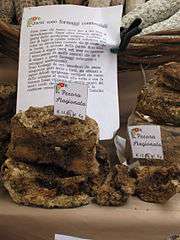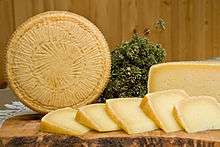Pecorino
| Pecorino | |
|---|---|
|
| |
| Country of origin | Italy |
| Source of milk | Sheep |
| Texture | Hard |
|
| |
Pecorino is a family of hard Italian cheeses made from ewe's milk. The word derives from Italian pecora meaning sheep.[1]
Overview

Of the six main varieties of Pecorino, all of which have Protected Designation of Origin (PDO) status under European Union law, Pecorino Romano is probably the best known outside Italy, especially in the United States, which has been an important export market for the cheese since the 19th century.[2] Most Pecorino is produced on the island of Sardinia, though its production is also allowed in Lazio and in the Tuscan Provinces of Grosseto and Siena. Ancient Roman authors wrote about this cheese and its production technique.[3]
The other five mature PDO cheeses are the Pecorino Sardo from Sardinia, Pecorino Toscano, whose production was already attested by Pliny the Elder in his Natural History,[4] Pecorino Siciliano (or Picurinu Sicilianu in Sicilian) from Sicily, Pecorino di Filiano from Basilicata[5] and Pecorino Crotonese from Crotone in Calabria.[6]
All come in a variety of styles depending on how long they have been aged. The more matured cheeses, referred to as stagionato ("seasoned" or "aged" ), are harder but still crumbly in texture and have decidedly buttery and nutty flavours. The other two types semi-stagionato and fresco have a softer texture and milder cream and milk tastes.
Tradition

A variant from Southern Italy is Pecorino Pepato (literally, "peppered Pecorino"), to which black peppercorns are added. Today many other additions are made, for example walnuts or rocket or tiny pieces of white or black truffle. In Sardinia, the larvae of the cheese fly are intentionally introduced into Pecorino Sardo to produce a local delicacy called casu marzu.
A good Pecorino Stagionato is often the finish of a meal, served with pears and walnuts or drizzled with strong chestnut honey. Pecorino is also often used to finish pasta dishes, and used to be the natural choice for most Italian regions from Umbria down to Sicily, rather than the more expensive Parmigiano-Reggiano. It is still preferred today for the pasta dishes of Rome and Lazio, for example Pasta dressed with sugo all'amatriciana, Pasta Cacio e pepe, and Pasta alla Gricia.
See also
References
- ↑ pecorino, n. OED Online. December 2013. Oxford University Press. Accessed 7 January 2014.
- ↑ Export statistics from the producers’ consortium
- ↑ Italian Pecorino and Ancient Roman
- ↑ Pecorino Toscano Consortium for the Protection of Tuscan Pecorino (in Italian)
- ↑ Guide to PDO and PGI products: Pecorino of Filiano
- ↑ http://www.guffantiformaggi.com/en/chees/crotone-pecorino-cheese
External links
 Media related to Pecorino at Wikimedia Commons
Media related to Pecorino at Wikimedia Commons